Is regular everyday mercury Hg or Hg2?

Regular elemental mercury exists as monoatomic Hg(0), not as a diatomic molecule Hg2. It is a metal composed of individual mercury atoms rather than paired atoms forming Hg2 units.
Metallic mercury at room temperature and standard conditions consists of single mercury atoms. This monoatomic nature distinguishes elemental mercury from some mercury ions that can form diatomic units.
Understanding Mercury’s Different Oxidation States and Species
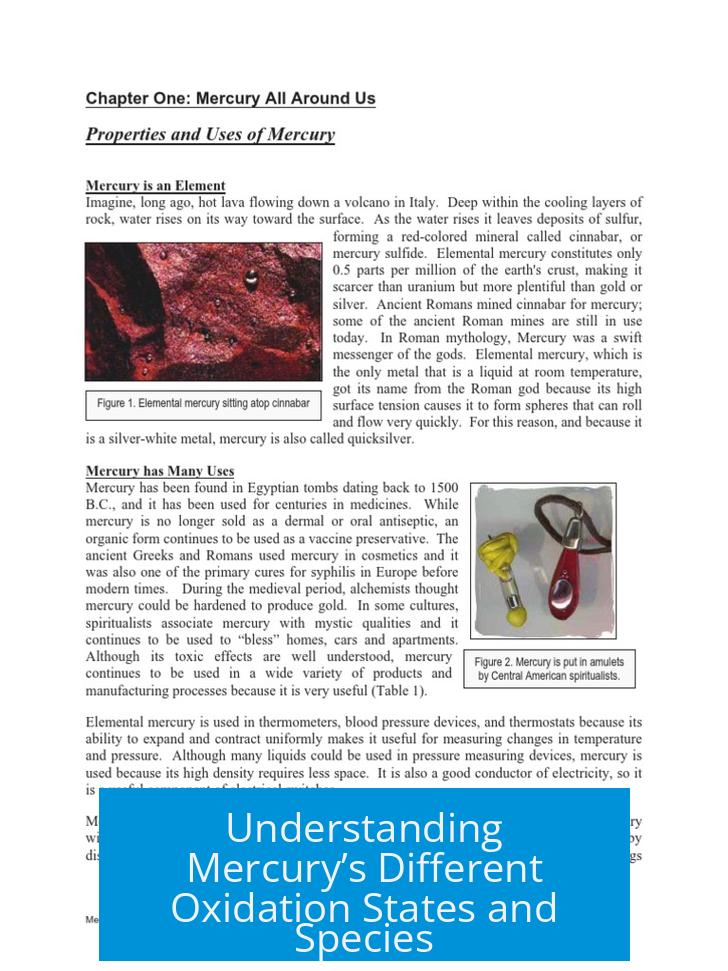
Mercury (0): Elemental Mercury
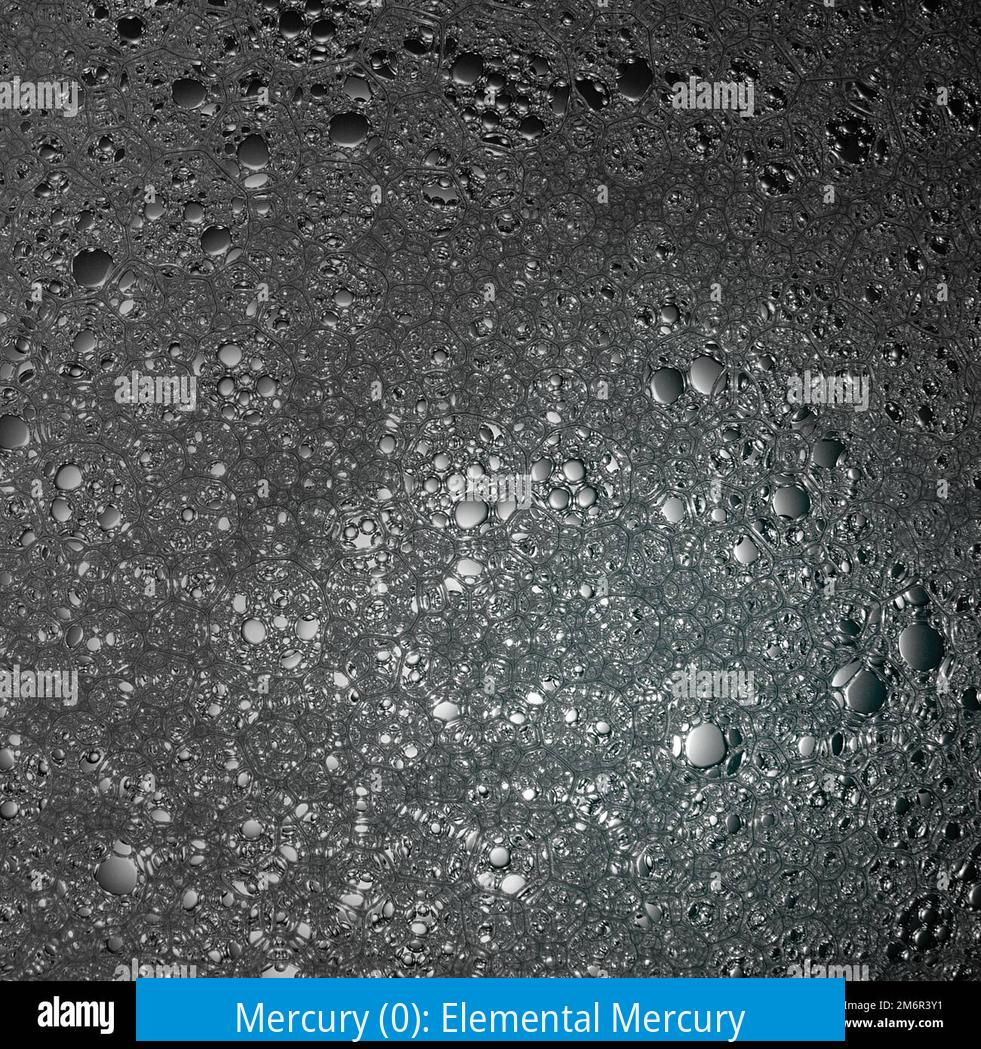
Elemental mercury, denoted Hg(0), is a liquid metal at room temperature. Each mercury atom exists independently without forming direct bonds to neighboring mercury atoms. This contrasts with some other metals that form metallic lattices. Mercury’s unique electron configuration influences its liquid state and monoatomic character.
Mercury (I) Compounds: Existence of Hg22+

Mercury (I) compounds contain the Hg22+ ion, a diatomic ion composed of two mercury atoms bonded together. It is a stable species in aqueous solution and is diamagnetic, highlighting paired electrons.
This ion forms because of overlapping orbitals, particularly the 4f and 4s shells on each mercury atom. Such orbital overlap provides sufficient bond strength to maintain the Hg–Hg bond within the ion. The bond length is optimized by these electronic interactions, enabling the two atoms to share a pair of electrons effectively.
Mercury (II) Compounds and Monatomic Hg2+
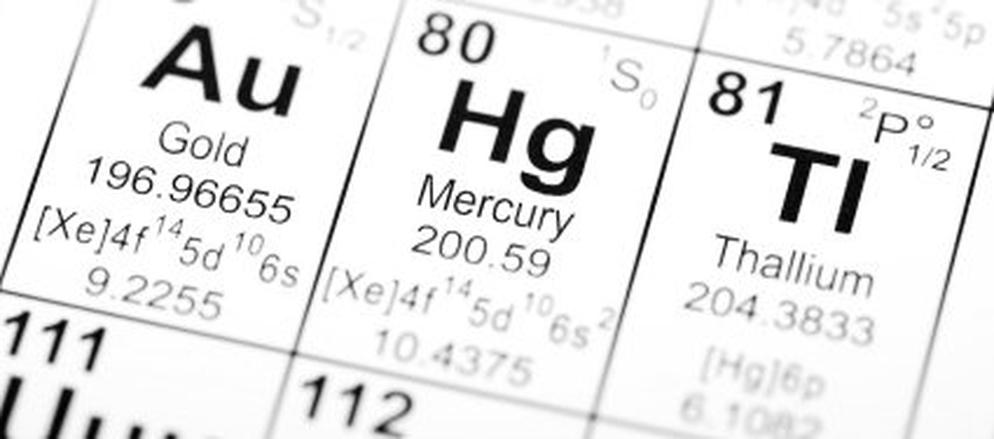
In contrast to mercury (I), mercury (II) compounds usually contain mononuclear Hg2+ ions. These ions do not pair up to form Hg2 units. The Hg2+ ion is paramagnetic and lacks the metal-metal bonding seen in mercury (I) species.
Why Does Mercury Form Diatomic Ions Like Hg22+?

The formation of diatomic mercury ions hinges on electronic structure and bonding mechanics. Mercury atoms have filled inner d and f orbitals, alongside a filled outer s shell, which can overlap under specific conditions.
- Orbital Overlap: The 4f and 4s orbitals on each Hg atom overlap, facilitating metal-metal bonding.
- Bond Distance: The distance between atoms in Hg22+ ions optimizes bonding interactions.
- Energy Stabilization: The ion gains stability from the combined electronic properties, making the Hg–Hg bond energetically favorable.
This diatomic nature is unusual among metal ions and applies primarily to mercury (I) in aqueous solutions or certain mercury compounds.
Existence of Other Diatomic and Polymetallic Mercury Ions
Beyond the Hg22+ ion, mercury chemistry includes polymetallic ions like Hg32+. These contain three mercury atoms bonded together and display paramagnetic properties.
Such species arise from similar bonding mechanisms involving orbital overlap and optimized bond distances. Their presence indicates a capacity for mercury atoms to form small metal clusters in ionic form.
Comparison to Other Stable Diatomic Ions
Diatomic ions are rare but not unique to mercury. For example, the nitrogen molecule ion N2+ is a well-known diatomic ion. Transition metals can sometimes form metal-metal bonded ions. However, stable diatomic ions like Hg22+ are exceptional due to unique relativistic effects and electronic configurations in mercury.
Why Mercury Ions Do Not Form Larger, Nonionized Compounds
The formation of larger nonionized mercury clusters or polymers is limited by several factors:
- Electronic Configuration: Filled inner shells and relativistic contraction limit extensive metal-metal bonding beyond small clusters.
- Stability of Small Units: Small ions like Hg22+ achieve a stable electronic arrangement that larger clusters do not readily attain.
- Thermodynamics: Larger clusters are likely higher in energy and less stable compared to monatomic or diatomic ions.
- Solvation Effects: In aqueous solution, solvation stabilizes small ions more effectively than large neutral clusters.
Due to these reasons, mercury predominantly exists in the elemental form as monoatomic Hg(0) or as small cations (Hg22+, Hg2+) rather than forming extensive nonionized metal clusters.
Summary Table of Mercury Speciation and Ion Forms
| Species | Status | Bonds | Magnetism | Notes |
|---|---|---|---|---|
| Hg(0) (elemental mercury) | Monoatomic metal | No direct Hg–Hg bonding (liquid metal) | Diamagnetic | Standard elemental mercury |
| Hg22+ (Mercury (I)) | Diatomic ion | Hg–Hg bond via 4f and 4s orbital overlap | Diamagnetic | Stable aqueous species, contains two bonded Hg atoms |
| Hg2+ (Mercury (II)) | Monatomic ion | No metal-metal bonding | Paramagnetic | Common in dissolved mercury (II) compounds |
| Hg32+ (Polymetallic ion) | Triatomic ion | Multiple Hg–Hg bonds | Paramagnetic | Less common, forms small mercury clusters |
Key Takeaways
- Elemental mercury exists as monoatomic Hg(0), not as Hg2.
- Mercury (I) forms the stable diatomic ion Hg22+, featuring a Hg–Hg bond.
- Mercury (II) compounds contain monatomic Hg2+ ions without direct Hg–Hg bonding.
- Bonding in diatomic ions arises from orbital overlap (4f and 4s) and optimal bond distances.
- Some polymetallic mercury ions like Hg32+ also exist but are less common.
- Larger nonionized mercury clusters do not form readily due to electronic and thermodynamic constraints.
Is Regular Everyday Mercury Hg or Hg2? Exploring Diatomic Ions and Their Curiosities
Let’s cut to the chase. Regular everyday mercury is NOT Hg2, but rather a monoatomic form denoted Hg(0). That means when you see shiny, silvery mercury lurking in a thermometer or old barometer, you’re looking at single mercury atoms dancing solo, not paired up in a duet. So, if you ever wondered whether mercury walks the molecular walk as Hg2, the answer is a crisp “no.” But wait, mercury can be a bit more social under certain conditions, forming diatomic ions. Intrigued? Let’s unravel this metallic mystery!
The Lone Ranger: Mercury Metal as Monoatomic Hg(0)
Mercury, at room temperature, is the only metal that remains liquid. Its metallic state is quite unique.
- Metallic mercury exists as single atoms, Hg(0), freely flowing without bonding into molecules.
- Why? Metals usually form lattices or networks. Mercury’s shallow electronic orbitals and relativistic effects mean its atoms don’t cling tightly to neighbors in the liquid phase.
So contrary to diatomic gases like O2 or N2, mercury metal is a collection of individual atoms. Think of it as a bustling party with everyone standing solo, not paired off holding hands.
Mercury Gets Cozy: The Diatomic Ion Hg22+
Now, when mercury enters compounds—especially mercury (I) compounds—things get more interesting. Enter the diatomic mercury ion, Hg22+.
- This ion features two mercury atoms bonded together, carrying a net +2 charge.
- It is diamagnetic, meaning all electrons are paired; this is due to unusual electronic interactions involving the 4f and 4s electron shells.
- Bond distances and electronic orbital overlap stabilize this pair nicely.
The story here is that these two mercury atoms “shake hands” through overlapping orbitals that help hold them together despite their ionic charge. It’s like they found a special handshake that makes their bond robust.
What About Hg(II)? Monoatomic, Not Mates
The mercury (II) ion, commonly encountered in dissolved mercury compounds, is quite different. It stays monatomic—just one mercury atom carrying a +2 charge. There’s no Hg22+ equivalent here; they prefer flying solo.
Beyond Pairs: Polymagnetic Mercury Ions like Hg32+
Mercury doesn’t always stop at pairs. In some exotic species, triatomic ions like Hg32+ exist. These ions feature three mercury atoms bonded and carry a positive charge.
Still, these are rare and require special conditions. Their stability, like the diatomic ion’s, comes from unique orbital interactions and optimized bond lengths.
Why No Larger Nonionized Mercury Compounds?
You might wonder, “If mercury can buddy up in pairs or threes, why not form bigger, nonionized clusters or molecules?” Good question.
While the data doesn’t spell this out explicitly, the evidence suggests:
- Orbital overlap and bond distances that stabilize Hg22+ and Hg32+ don’t extend favorably to larger clusters.
- Large nonionized compounds might be electronically or sterically unfavorable.
- Mercury metal prefers its monatomic freedom rather than forming tight clusters in elemental form.
In other words, small clusters hit the “sweet spot” of stability; bigger gets complicated fast. It’s like forming a band of two or three musicians is easier to coordinate than a full orchestra.
Any Other Stable Diatomic Ions?
Mercury’s diatomic ion is a fascinating example, but it’s not alone in the diatomic ion club.
- Some other elements form stable diatomic ions, like the dioxygenyl ion O2+, with a positive charge on an oxygen molecule.
- Halogens form diatomic neutral molecules (like Cl2), but their ions are less stable as diatomic charged species.
- Mercury’s heavy atoms and electron shell structure help it uniquely stabilize such diatomic ions.
In essence, while diatomic ions are not a huge family, mercury is a notable member thanks to its relativistic and electronic quirks.
Why Should You Care?
Understanding whether mercury is Hg or Hg2 isn’t just trivia.
- It affects how mercury behaves in the environment. Mercury’s chemistry influences how toxic it is and how it moves through ecosystems.
- It impacts analytical chemistry techniques that detect mercury species.
- It’s vital for designing mercury-containing compounds in industrial or medical applications.
Knowing when mercury pairs up—and when it keeps its distance—lets scientists predict and control mercury’s behavior better.
Key Takeaways and Final Thoughts
Here’s the mercury mercury moment: regular liquid mercury is monatomic Hg(0), not a diatomic molecule Hg2. But in its mercury (I) ionic form, it forms a unique diatomic ion Hg22+ stabilized by orbital overlaps. Mercury also forms triatomic ions like Hg32+ under special conditions, but it doesn’t favor forming larger clusters or nonionized compounds, thanks to orbital and bonding constraints.
Other stable diatomic ions are rare, but mercury’s heavy atom structure makes it a standout. This knowledge opens windows into mercury’s chemical antics and helps tackle challenges from pollution to applications.
And if you ever think mercury might be playing singles or couples, remember: most of the time, it’s happy as a solo act, but it can get cozy when chemistry calls.
Is regular everyday metallic mercury Hg or Hg₂?
Regular mercury is monoatomic Hg(0). It does not naturally exist as Hg₂ in its metallic form. As a metal, mercury atoms stand alone rather than pairing up as diatomic molecules.
Are there other stable diatomic ions besides Hg₂²⁺?
Yes, mercury forms diatomic ions like Hg₂²⁺, and also polymagnetic species such as Hg₃²⁺. These ions are stabilized by atomic orbital overlaps specific to mercury.
Why does the Hg₂²⁺ ion form even though it is still an ion?
Hg₂²⁺ forms due to overlapping 4f and 4s atomic orbitals. This bonding creates stability despite the ion’s charge. The bonding reduces energy and holds two mercury atoms together.
Why don’t mercury ions form larger nonionized compounds?
The content does not directly explain this. However, the stable bonding in small diatomic or triatomic ions and mercury’s metallic character likely limit larger, neutral species from forming.
What makes Hg₂²⁺ diamagnetic compared to other mercury ions?
Hg₂²⁺ is diamagnetic because the paired electrons in the bond cancel magnetic effects. In contrast, most Hg²⁺ ions lack this paired bonding and are not diamagnetic.


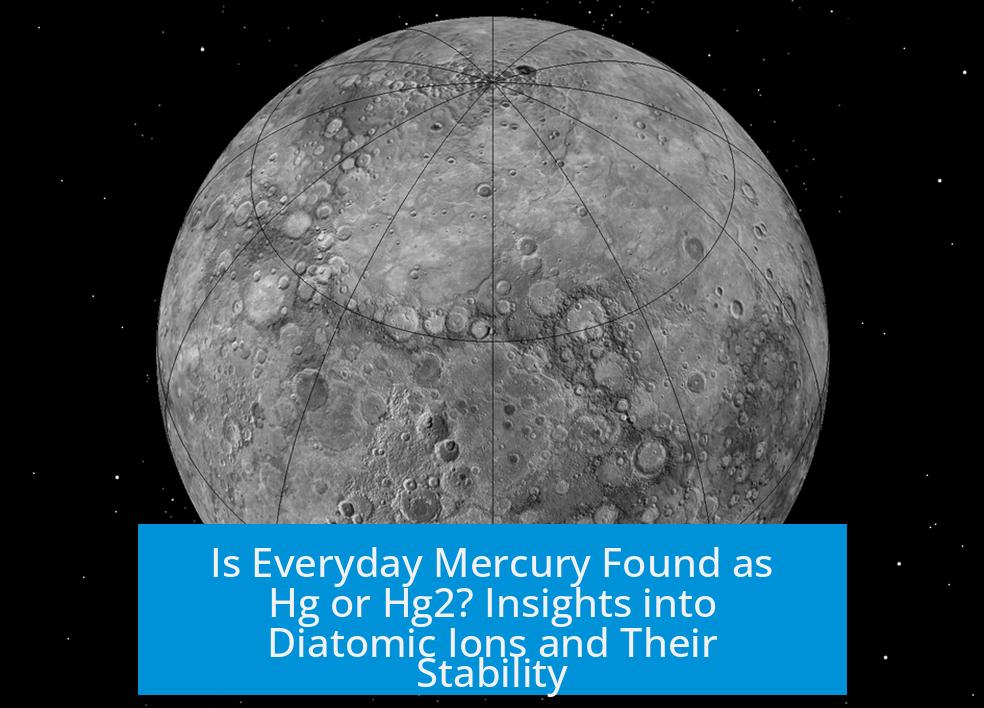

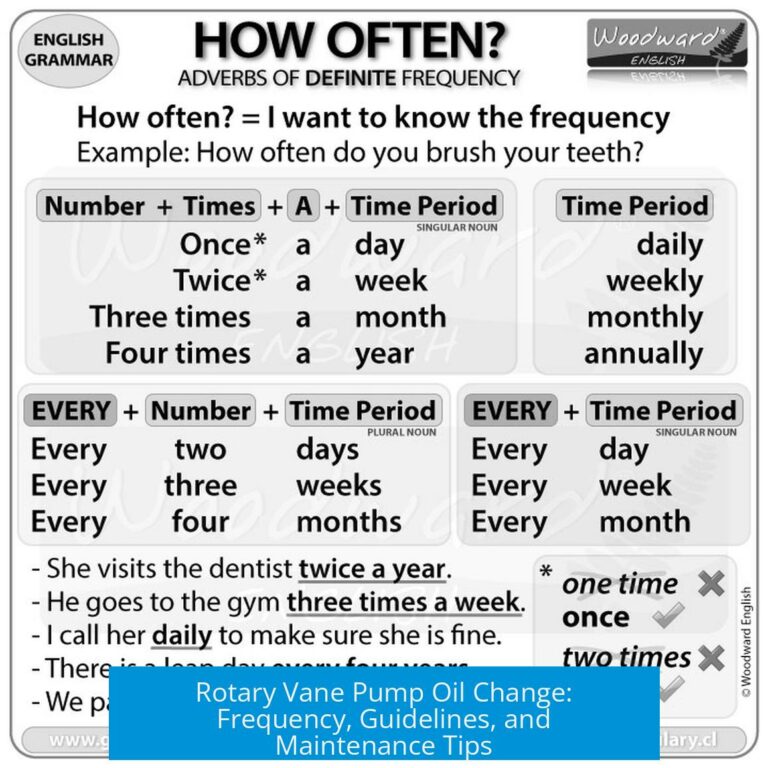
Leave a Comment